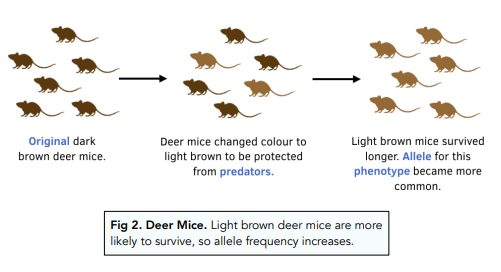Variation - Evolution and Natural Selection (GCSE Biology)
Evolution and Natural Selection
Natural Selection and Evolution
Key Terms
Evolution refers to a change in the alleles, and thus inherited characteristics, in a population of a species over time. Evolution has led to changes in the phenotypes of species over time, in order to make them more suitable to their environment. This has occurred through a process called natural selection.
Natural selection is a process that leads organisms to be more and more adapted to their surroundings in order to survive for longer and reproduce more. It was coined and studied by the famous biologist, Charles Darwin.
Adaptation is the process resulting from natural selection, by which populations become more suited to their environment over many generations.

Survival of the Fittest
The theory of ‘survival of the fittest’ nicely encompasses natural selection. Survival of fittest basically means that the more adapted the organism is to the surroundings, the more likely it is to survive and reproduce.
An example of this are the deer mice. These animals migrated to the sand hills in Nebraska and changed colour from dark brown to light brown. This protected them from predators. The lighter mice survived for longer until this allele become common throughout the species.

On the Origin of Species
Charles Darwin wrote a book called ‘On the Origin of Species’ in the 1850s, in which he attempted to describe evolution and how it works.
One of the most important principles coming from this is that all species of living things evolved from very simple life forms and eventually became more and more complex through evolution. This process began more than three billion years ago.
Stages of Natural Selection
Here is a diagram to explain natural selection.




Speciation
Understanding Speciation
Speciation is the formation of a new species. Species form when the phenotypes of two organisms in the same species gets distinctly different.
There is a key way of working out whether a new species is formed. If two organisms can no longer freely interbreed to produce fertile offspring, they belong to different species.
Example: Speciation in Monkeys
Natural selection can lead to formation of a new species if there is a split in the population. For example, geographical isolation could separate two populations of monkeys over two islands.

A mutation in one monkey (grey) can help improve ability to climb trees and reach food.

This mutation spreads via natural selection to the other monkeys on the same island. There is a reproductive barrier (the river) between both populations, so the mutation doesn’t spread to the other monkeys.

Over time, the two populations become so different that they can no longer breed together – two different species are formed.
Variation refers to differences in traits among individuals within a species. These differences can be physical, such as differences in eye color, or behavioral, such as differences in feeding habits.
Evolution is the process by which species change over time through the accumulation of genetic mutations and variations. Over generations, these variations can lead to the development of new species.
Natural selection is the process by which certain traits become more common in a population over time because they provide an advantage for survival and reproduction. The individuals with these advantageous traits are more likely to pass on their genes to the next generation, and eventually the population will be composed of individuals with these advantageous traits.
Variation, evolution, and natural selection are closely related. Variation provides the raw material for evolution, and natural selection determines which variations are passed on to future generations. Over time, the accumulation of advantageous variations through natural selection leads to the process of evolution.
Over time, populations with different advantageous variations may become isolated from each other, leading to the development of different species. This occurs because the different populations are no longer able to interbreed with each other, and over time they may develop distinct characteristics.
Adaptation refers to the process by which a species changes over time in response to its environment. This can occur through natural selection, where advantageous variations are selected for, or through genetic mutations, which can lead to new traits.
Evolution can occur over a long time frame, and it may not be possible to observe it in real-time. However, the process of evolution can be observed in laboratory settings, such as with bacteria that evolve resistance to antibiotics.
The evidence for evolution includes the fossil record, which provides a record of the history of life on earth, and comparative anatomy and physiology, which show the similarities and differences among species. Additionally, the study of DNA provides strong evidence for evolution, as it demonstrates the genetic relationships among species.
Artificial selection is the process by which humans select certain traits in plants and animals and breed them to produce offspring with those traits. This process has been used to produce domesticated plants and animals that have desirable traits, such as improved yields or resistance to disease.
Artificial selection is different from natural selection in that it is directed by human intervention, whereas natural selection is driven by the environment. Artificial selection can result in the development of new traits that would not be selected for in nature, whereas natural selection results in the development of traits that provide an advantage for survival and reproduction in the natural environment.






Still got a question? Leave a comment
Leave a comment